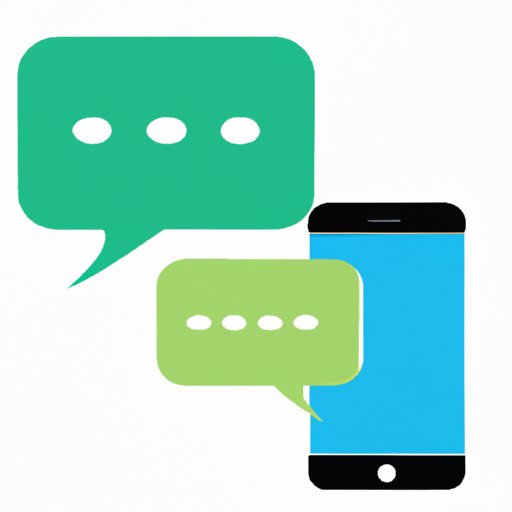Introduction
If you’re an iPhone user, you’re likely familiar with the different colors iMessages can appear in. Blue means your message was sent through the iMessage service, while green means you sent an SMS text message through your cellular provider. But why do some of your messages appear as green bubbles? In this article, we’ll explore the reasons behind green iMessages, the pros and cons of message colors, and what your iPhone might be trying to tell you through its message bubbles.
The Reasons Behind Your Green iMessage: An In-Depth Analysis
To understand why your iMessages are green, it’s important to know how the iMessage system works. When you message another iPhone user through the Messages app, your messages will be sent as iMessages if both devices have an internet connection. If not, your message will be sent as a text message (SMS) through your cellular provider.
There are a few possible causes for green iMessages:
Network Issues
If your message appears green, it could mean that your device is having trouble connecting to the internet. Check your Wi-Fi or cellular data connection to make sure your device is online. If your connection is weak or unstable, your message may be sent as an SMS instead of an iMessage.
iMessage Settings
You may have inadvertently turned off iMessage by accident or changed your settings so that your messages are sent as SMS. Check your iMessage settings in the Messages app to ensure that iMessage is turned on and set as your default messaging service.
The Pros and Cons of Green vs. Blue iMessages
While the color of your iMessages may seem like a small detail, it can have significant implications in different situations.
Pros and Cons of Green iMessages
When you send a message that appears green, it means that your message was sent as an SMS text message instead of an iMessage. While this may not seem like a big deal, there are a few pros and cons to consider:
Pros:
- You can send SMS text messages to non-iPhone users: If your recipient doesn’t have an iPhone or iMessage, you can still message them using SMS.
- Your message will be sent even if there’s no internet connection: If you’re in an area with poor or no internet connection, your message will still be sent as an SMS text message.
Cons:
- Your iMessage won’t be encrypted: Unlike iMessages, SMS text messages are not encrypted, meaning they can potentially be intercepted or read by others.
- Your message won’t be sent as quickly: Unlike iMessages, SMS text messages may take longer to send and receive.
Pros and Cons of Blue iMessages
When you send a message that appears blue, it means that your message was sent as an iMessage instead of an SMS text message.
Pros:
- Messages are encrypted for added security: iMessages are encrypted, meaning they’re more secure than SMS text messages.
- Messages send and receive faster: iMessages are sent and received much faster than SMS text messages.
- You can receive read receipts: If your recipient has enabled read receipt notifications, you’ll be able to see when they’ve read your message.
Cons:
- You can only send iMessages to other iPhone, iPad, or Mac users: If your recipient doesn’t have an iPhone or iMessage, you won’t be able to message them using iMessage.
- Your message won’t be sent if there’s no internet connection: If you’re in an area with poor or no internet connection, your message won’t be sent.
Is Your iPhone Trying to Tell You Something? A Philosophical Reflection on Green iMessages
The color of your iMessage may seem inconsequential, but it can have a significant impact on how your message is perceived. When you see a message that appears green, you might assume that the recipient is not an iPhone user or that they’re not online. This can affect how you interpret the message and can even change the message’s implications.
Additionally, many of us attach different values to different colors. For example, green is often associated with environmentalism, while blue is associated with trust and reliability. Could the color of your message bubble affect how the recipient perceives your message? It’s possible.
Green iMessages: An Interesting Quirk or a Sign of a Bigger Problem?
Some iPhone users may be concerned if their messages appear green instead of blue. While it’s usually due to a network issue or iMessage setting, it could also be indicative of a larger problem with your device’s functionality.
If you’re experiencing other issues with your iPhone or feel like it’s not performing as well as it should be, consider running a diagnostic check using Apple’s diagnostic tool. You can also contact Apple support for further assistance.
Green iMessages vs. Blue iMessages: Which is Better and Why?
After weighing the pros and cons of each message color, the answer to which is better largely depends on your individual needs and situation. If you frequently message non-iPhone users or are in an area with poor internet connection, green messages may be more practical. If speed and security are your priorities, blue messages may be the better choice.
Ultimately, the color of your message may not matter much in the grand scheme of things. As long as your message gets across clearly and effectively, that’s what counts.
Conclusion
In this article, we’ve explored the reasons behind green iMessages, the pros and cons of message colors, and how the color of your message bubble can affect communication and interpretation. While the color of your message may not always be in your control, keeping in mind the implications of each color can help you communicate more effectively with others. If you’re experiencing issues with your iMessage settings or network connection, try troubleshooting the problem using the tips we’ve provided.
